1AM2U1My abilities
1AM2U1 My ablities 单元整体设计

Oxford English 1A Module 2 Unit 1 My abilities单元整体设计2014学年度第一学期M2U1 My abilities单元教学整体设计一、单元教学目标:1.语言知识目标:a.在语境中学习、理解、认读单词:dance, read, sing, drawb.在语境中理解运用单词和词组:write, write ABC, dance very well, read a book,sing a song, draw a facec.在语境中理解认读句型:What can you do? I can...d.在语境中理解运用拓展句型:What can Danny do? Danny can...2. 技能与运用目标:a能用优美的语音语调模仿朗读和表演文本。
b.能正确运用所学单词和句型介绍自己。
c能根据情境整合所学句型进行对话交流。
3. 情感态度目标:在情境的渲染下,让孩子们试着用英语介绍自己能做的事情以及询问他人的能力。
二、单课教学目标: 1. 第一课时Topic: Mickey’s abilities2. 第二课时Topic: My abilities具体单课设计如下:第一课时:一、学情分析:本次执教班级为一(4)班,共有学生31人。
经过一个多月的互相了解和磨合,能够形成一定的默契度。
同学们能较为熟练地开展同伴互动和小组活动,能较有效的在游戏和活动中习得知识。
一年级小朋友活泼好动,课上注意力集中时间较短,需要老师的提醒和关注。
二、基于学情的教材处理:根据学生实际情况,我们对教材做了如下处理:本单元以Mickey为主线.,第一课时话题定为Mickey’s abilities.在Mickey介绍自己的本领的情境中学习掌握单词句型和文本。
本课时为第一课时,藉由Mickey介绍自己的本领的情境中学习掌握本单元的四个重点单词dance, read, sing, draw; 初步感知词组:dance very well, read a book, sing a song, draw a face以及本课时句型:I can... 能模仿Mickey 的介绍进行改编,形成自己的自我介绍。
2AM2U11st 反思1
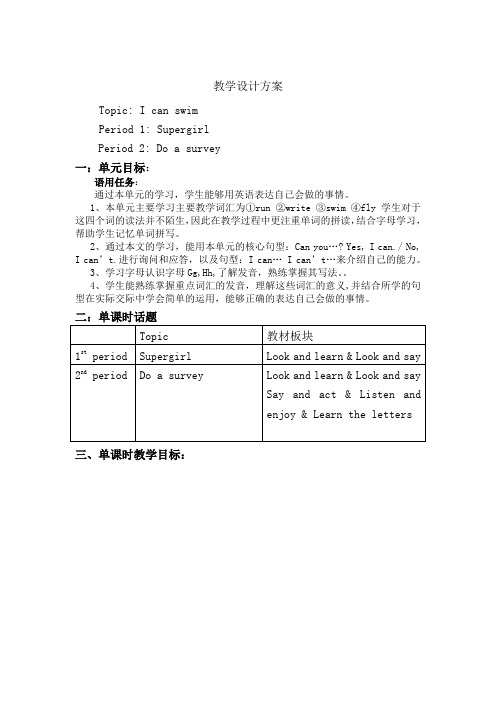
教学设计方案Topic: I can swimPeriod 1: SupergirlPeriod 2: Do a survey一:单元目标:语用任务:通过本单元的学习,学生能够用英语表达自己会做的事情。
1、本单元主要学习主要教学词汇为①run ②write ③swim ④fly 学生对于这四个词的读法并不陌生,因此在教学过程中更注重单词的拼读,结合字母学习,帮助学生记忆单词拼写。
2、通过本文的学习,能用本单元的核心句型:Can you…? Yes, I can./ No,I can’t.进行询问和应答,以及句型:I can… I can’t…来介绍自己的能力。
3、学习字母认识字母Gg,Hh,了解发音,熟练掌握其写法。
4、学生能熟练掌握重点词汇的发音,理解这些词汇的意义,并结合所学的句型在实际交际中学会简单的运用,能够正确的表达自己会做的事情。
二:单课时话题三、单课时教学目标:四、核心内容分析:本课教学内容源于教材2AM2U1 I can swim.,本单元学习目标是有关于介绍自己会做的事情。
我将本单元分为二课时。
第一课时,通过“Supergirl”的语境,让学生学会运用核心词汇及句型I can…和I can’t…来表达自己会做什么,不会做什么。
最后让学生在语境中流利的进行介绍,在表演中,达成语用目标。
第二课时,在本科的基础上,通过“Do a survey”的语境,熟悉Can you/she/he…?的不同询问及正确回答。
五:学生实际:知识:在一年级授课时,本课的四个核心词汇教师都提到过,学生想必都不陌生。
但是二年级更加侧重单词的拼读。
好在学生对于熟悉的只是还能够运用得当。
另外核心句型Can you/she/he…?的问答学生也掌握得当,但对二年级的学生来说要搞清楚不同的人物用不同的人称代词是一个难点。
能力:学生热情积极,发言面较广,能积极参与课堂活动,对学习内容的反馈比较多元。
大部分学生具有一定的模仿能力,具有一定的表达、表现欲。
Module2Unit1myabilities(教学设计)牛津上海版(试用本)英语一年级上册
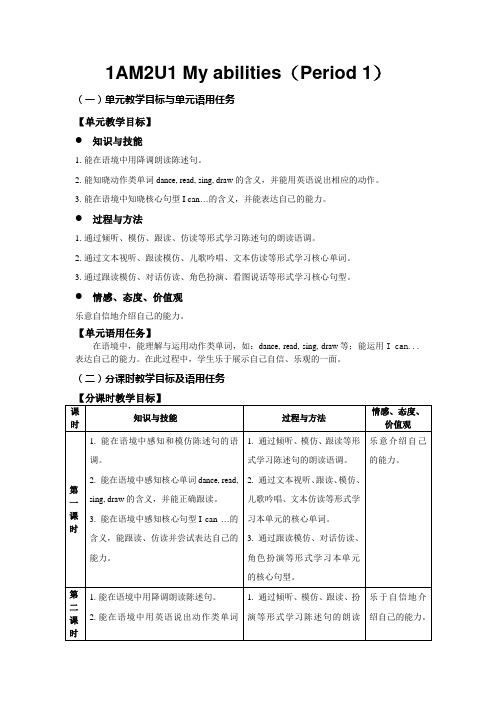
1AM2U1 My abilities(Period 1)(一)单元教学目标与单元语用任务【单元教学目标】●知识与技能1.能在语境中用降调朗读陈述句。
2.能知晓动作类单词dance, read, sing, draw的含义,并能用英语说出相应的动作。
3.能在语境中知晓核心句型I can…的含义,并能表达自己的能力。
●过程与方法1.通过倾听、模仿、跟读、仿读等形式学习陈述句的朗读语调。
2.通过文本视听、跟读模仿、儿歌吟唱、文本仿读等形式学习核心单词。
3.通过跟读模仿、对话仿读、角色扮演、看图说话等形式学习核心句型。
●情感、态度、价值观乐意自信地介绍自己的能力。
【单元语用任务】在语境中,能理解与运用动作类单词,如:dance, read, sing, draw等;能运用I can...表达自己的能力。
在此过程中,学生乐于展示自己自信、乐观的一面。
(二)分课时教学目标及语用任务第一课时教学设计一、教学目标(Objectives)、1、通过图片,动作和情境,初步学习如下表示动作的单词:dance, sing, read, draw等,感受单词的音,形,义;2、通过图片,动作和情境,初步学习句型:I can…等,初步了解其含义,能进行简单运用;3、通过情境,让学生乐于展示与表达自己的能力,并为自身能力感到自豪。
二、教学重点(Teaching focus)、能在语境中听懂并正确跟读核心单词dance, read, sing, draw,能理解、跟读、仿读核心句型I can…三、学习难点(Learning difficulty)尝试用I can…表达自己的能力。
四、教学过程(Teaching procedures)Assignment 1. Listen and read on P14(聆听、跟读第14页,3遍)2. Try to say and show your abilities to your parents(尝试着把自己能做的动作跟父母分享):I can _________. How ________!通过听,读和说全面复习和巩固所学内容。
My abilities(我的)
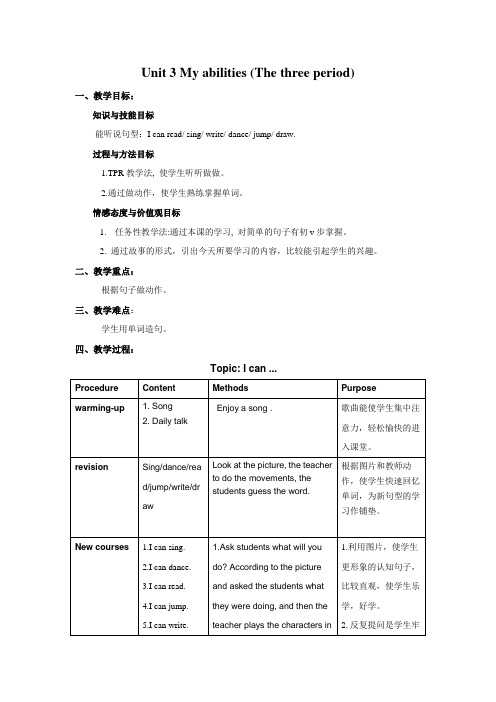
Unit 3 My abilities (The three period)一、教学目标:知识与技能目标能听说句型:I can read/ sing/ write/ dance/ jump/ draw. 过程与方法目标1.TPR 教学法, 使学生听听做做。
2.通过做动作,使学生熟练掌握单词。
情感态度与价值观目标1. 任务性教学法:通过本课的学习, 对简单的句子有初v 步掌握。
2. 通过故事的形式,引出今天所要学习的内容,比较能引起学生的兴趣。
二、教学重点:根据句子做动作。
三、教学难点:学生用单词造句。
四、教学过程:Topic: I can ...ProcedureContent Methods Purposewarming-up1. Song2. Daily talkEnjoy a song .歌曲能使学生集中注意力,轻松愉快的进入课堂。
revisionSing/dance/rea d/jump/write/dr awLook at the picture, the teacher to do the movements, the students guess the word.根据图片和教师动作,使学生快速回忆单词,为新句型的学习作铺垫。
New courses1.I can sing.2.I can dance.3.I can read.4.I can jump.5.I can write.1.Ask students what will you do? According to the picture and asked the students what they were doing, and then theteacher plays the characters in 1.利用图片,使学生更形象的认知句子,比较直观,使学生乐学,好学。
2.反复提问是学生牢6.I can draw.the picture, said: Yes, I will do.2.Say “Can you sing?I cansing.Do the action to elicit thenew sentences.3.And so on.4.Ask “What can (names) do?”“What does she/he say?”牢记住句型。
1AM2U1P1精备
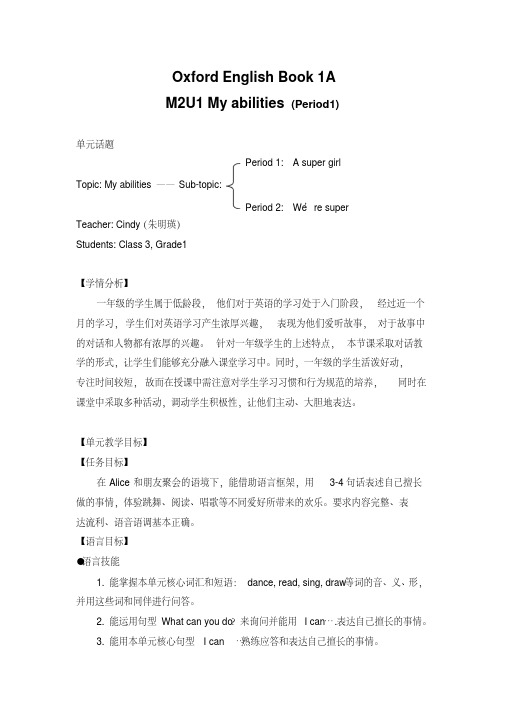
Oxford English Book 1A M2U1 My abilities (Period1)单元话题Topic: My abilities —— Sub-topic:Teacher: Cindy (朱明瑛)Students: Class 3, Grade1【学情分析】一年级的学生属于低龄段,他们对于英语的学习处于入门阶段,经过近一个月的学习,学生们对英语学习产生浓厚兴趣,表现为他们爱听故事,对于故事中的对话和人物都有浓厚的兴趣。
针对一年级学生的上述特点,本节课采取对话教学的形式,让学生们能够充分融入课堂学习中。
同时,一年级的学生活泼好动,专注时间较短,故而在授课中需注意对学生学习习惯和行为规范的培养,同时在课堂中采取多种活动,调动学生积极性,让他们主动、大胆地表达。
【单元教学目标】【任务目标】在Alice 和朋友聚会的语境下,能借助语言框架,用3-4句话表述自己擅长做的事情,体验跳舞、阅读、唱歌等不同爱好所带来的欢乐。
要求内容完整、表达流利、语音语调基本正确。
【语言目标】●语言技能1. 能掌握本单元核心词汇和短语:dance, read, sing, draw 等词的音、义、形,并用这些词和同伴进行问答。
2. 能运用句型What can you do ?来询问并能用I can ….表达自己擅长的事情。
3. 能用本单元核心句型I can … 熟练应答和表达自己擅长的事情。
Period 1: A super girlPeriod 2: We ’re super在语境中,体验不同爱好给自己和朋友所带来的乐趣,对自已拥有的能力产生自信。
在进行调查的时候,多鼓励和表扬他人所拥有的能力。
●学习策略在课堂活动中,能注意观察,认真倾听,大胆尝试,用英语进行思维活动,并养成良好的学习习惯。
【教具、学具准备】PPT, 单词卡,粘纸【分课时教学目标】课时任务目标语言目标第一课时能在Alice和朋友聚会的语境中,在图片和句型结构的帮助下,描述自己拥有的能力。
2019-2020年小学英语一年级Module2Me,myfamilyandfriendsUnit1Myabilities2课时全英文教案
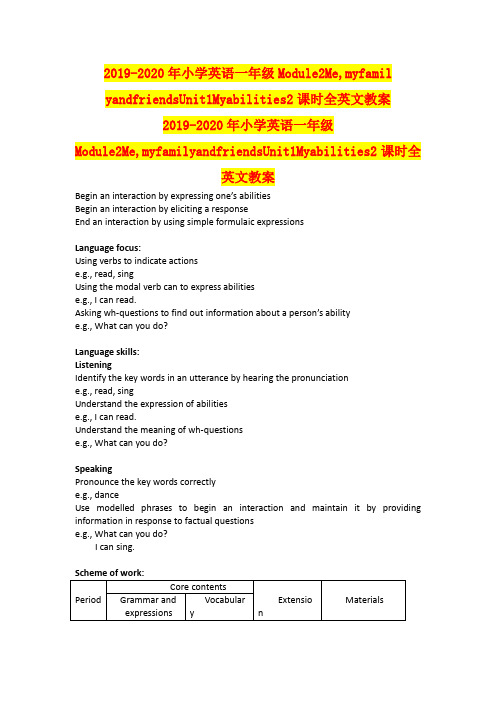
2019-2020年小学英语一年级Module2Me,myfamilyandfriendsUnit1Myabilities2课时全英文教案2019-2020年小学英语一年级Module2Me,myfamilyandfriendsUnit1Myabilities2课时全英文教案Begin an interaction by expressing one’s abilitiesBegin an interaction by eliciting a responseEnd an interaction by using simple formulaic expressionsLanguage focus:Using verbs to indicate actionse.g., read, singUsing the modal verb can to express abilitiese.g., I can read.Asking wh-questions to find out information about a person’s abilitye.g., What can you do?Language skills:ListeningIdentify the key words in an utterance by hearing the pronunciatione.g., read, singUnderstand the expression of abilitiese.g., I can read.Understand the meaning of wh-questionse.g., What can you do?SpeakingPronounce the key words correctlye.g., danceUse modelled phrases to begin an interaction and maintain it by providing information in response to factual questionse.g., What can you do?I can sing.Period 1Language focus:Using verbs to indicate actionse.g., read, sing, dance, drawUsing the modal verb can to express abilitiese.g., I can....Language skills:ListeningIdentify the key words in an utterance by hearing the pronunciation e.g., read, sing, dance, drawUnderstand the expression of abilitiese.g., I can read.Hear specific information in response to questionse.g., What can you do?I can…SpeakingPronounce the key words correctlye.g., read, singUse formulaic expressions to indicate one’s abilitiese.g., I can…Materials:Student’s Book 1A, p p.14 and 17Workbook 1A, p.14 Parts A and BCassette 1ACassette playerFlashcards 1A (dance, read, sing, draw)Some photos of famous peoplePre-task preparationsWhile-task proceduresPost-task activitiesHomework: 1.Review the rhyme “I can …”2.Inquire about one’s parents’ abilities in English.Period 2Language focus:Asking wh-questions to find out a person’s abilitye.g., What can you do?Using verbs to indicate actionse.g., I can sing.Language skills:ListeningHear specific information in response to questionse.g., What can you do?I can…SpeakingUse modelled phrases to begin an interaction and maintain it by providing information in response to factual questions.e.g., I can sing.Begin an interaction by eliciting a responsee.g., What can you do?I can…Materials:Student’s Book 1A pp.15 and 16Workbook 1A, pp.15,16 and17 Parts C and DCassette1ACassette playerFlashcards 1A (dance, read, sing, draw)Pre-task preparations附送:2019-2020年小学英语一年级Module2Me,myfamilyandfriendsUnit2Myfamily2课时全英文教案Tasks in this unit:Begin an interaction by introducing one’s family members.End an interaction by using simple formulaic expressions.Begin an interaction by eliciting a response.Language focus:Using pronouns to identify peoplee.g., meUsing nouns to identify family memberse.g., motherUsing possessive adjectives to express possessione.g., my motherAsking wh-questions to find out a person’s identifye.g. Who is she?Using pronouns to identify peoplee.g., She’s Kitty.Using formulaic expressions to confirm or denye.g., Yes./No.Language skills:ListeningIdentify the key words in an utterance by hearing the pronunciatione.g., grandfather, grandmother, father, motherHear specific information in response to questionse.g., Who is she?She is my grandmother.SpeakingPronounce the words, phrases and sentences correctlye.g., grandfather, grandmother, father, motherUse modelled phrases to begin an interaction and maintain it by providing a response to factual questions.e.g. Who’s she?She’s my grandmother.Period 1Language focus:Using pronouns to identify peoplee.g., meUsing nouns to identify family memberse.g., mother, father, grandmother, grandfatherLanguage skills:ListeningIdentify the key words in an utterance by hearing the pronunciation SpeakingUse modeled phrases to communicate with other studentse.g., A book!Pronounce the words , phrases and sentences correctly Materials:Student’s Book 1A, pp.18 and 51Work book 1A, pp.18 and 19 Parts A and BCassette 1ACassette playerWord and picture cards 1APhotos of family membersFinger puppetsPre-task preparationsAids: Photos of family membersWhile-task procedures Aids: Photos of family membersPost-task activitiesAids: Student’s Book page 51Homework:Listen and read the words.Period 2Language focus:Using nouns to identify family memberse.g., mother, father, grandfather, grandmotherUsing possessive adjectives to express possessione.g., my motherAsking wh-questions to find out a person’s identifye.g. Who is she?Using pronouns to identify peoplee.g., She’s my grandmother.Using formulaic expressions to confirm or denye.g., Yes./No.Language skills:ListeningIdentify the key words in an utterance by hearing the pronunciatione.g., mother, father, grandfather, grandmotherHear specific information in response to questionse.g., Who is she? She’s my grandmother.Hear specific information in response to questionse.g., Yes./No.SpeakingUse modelled phrases to begin an interaction and maintain it by providing responses to factual questions.e.g. Who’s she? She’s my grandmother.Use formulaic expressions to introduce a persone.g., She is Kitty.Teacher’s Book 30Begin an interaction by eliciting a responsee.g., Who is she? She’s Alice. Yes, she’s Alice.Materials:Student’s Book 1A, pp19,20 and 21Workbook 1A, pp19,20 and 21 Parts C,D and TaskCassette 1ACassette playerPictures of people chosen from magazinesWord and picture cards 1A Photos of family membersPre-task preparationsAids: Cassette 1A, Cassette player,While-task proceduresAids: Cassette 1A, Cassette player Photos of family membersPost-task activitiesAids: Photos of family membersHomework:1. Listen and read the sentences.2. Act out the dialogue.。
my abilities初一英语作文
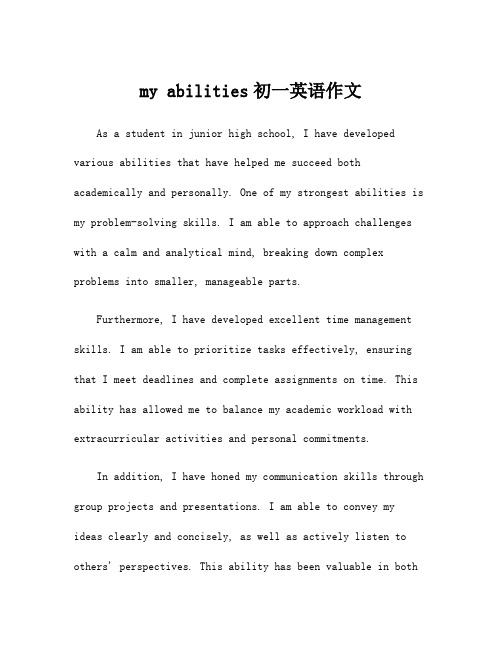
my abilities初一英语作文As a student in junior high school, I have developed various abilities that have helped me succeed both academically and personally. One of my strongest abilities is my problem-solving skills. I am able to approach challenges with a calm and analytical mind, breaking down complex problems into smaller, manageable parts.Furthermore, I have developed excellent time management skills. I am able to prioritize tasks effectively, ensuring that I meet deadlines and complete assignments on time. This ability has allowed me to balance my academic workload with extracurricular activities and personal commitments.In addition, I have honed my communication skills through group projects and presentations. I am able to convey my ideas clearly and concisely, as well as actively listen to others' perspectives. This ability has been valuable in bothcollaborative projects and everyday interactions with classmates and teachers.Finally, I have a strong work ethic and a growth mindset.I am willing to put in the effort to improve and learn from my mistakes. I believe that with hard work and perseverance, I can achieve any goal I set for myself.In conclusion, my abilities in problem-solving, time management, communication, and work ethic have been essential to my success in junior high school. I am confident that these skills will continue to serve me well in the future, enabling me to overcome challenges and reach my full potential.。
《My abilities》 知识清单
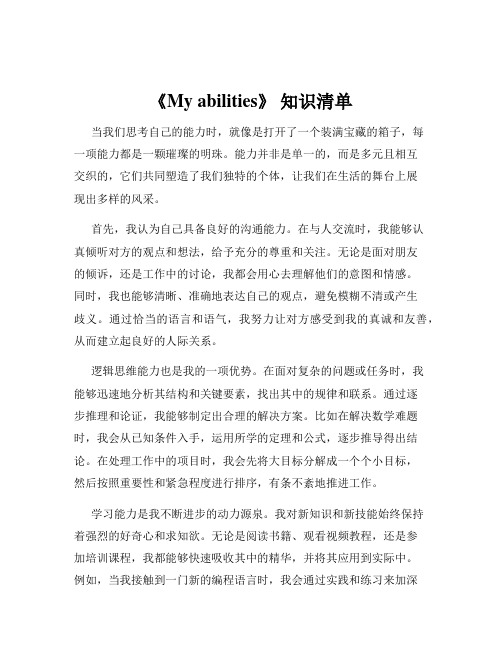
《My abilities》知识清单当我们思考自己的能力时,就像是打开了一个装满宝藏的箱子,每一项能力都是一颗璀璨的明珠。
能力并非是单一的,而是多元且相互交织的,它们共同塑造了我们独特的个体,让我们在生活的舞台上展现出多样的风采。
首先,我认为自己具备良好的沟通能力。
在与人交流时,我能够认真倾听对方的观点和想法,给予充分的尊重和关注。
无论是面对朋友的倾诉,还是工作中的讨论,我都会用心去理解他们的意图和情感。
同时,我也能够清晰、准确地表达自己的观点,避免模糊不清或产生歧义。
通过恰当的语言和语气,我努力让对方感受到我的真诚和友善,从而建立起良好的人际关系。
逻辑思维能力也是我的一项优势。
在面对复杂的问题或任务时,我能够迅速地分析其结构和关键要素,找出其中的规律和联系。
通过逐步推理和论证,我能够制定出合理的解决方案。
比如在解决数学难题时,我会从已知条件入手,运用所学的定理和公式,逐步推导得出结论。
在处理工作中的项目时,我会先将大目标分解成一个个小目标,然后按照重要性和紧急程度进行排序,有条不紊地推进工作。
学习能力是我不断进步的动力源泉。
我对新知识和新技能始终保持着强烈的好奇心和求知欲。
无论是阅读书籍、观看视频教程,还是参加培训课程,我都能够快速吸收其中的精华,并将其应用到实际中。
例如,当我接触到一门新的编程语言时,我会通过实践和练习来加深对它的理解,不断尝试编写不同的程序,从而提高自己的编程水平。
而且,我善于总结经验教训,从失败和错误中汲取教训,不断调整自己的学习方法和策略,以提高学习效率。
适应能力也是我值得骄傲的一点。
生活中充满了变化和不确定性,而我能够迅速调整自己的心态和行为,以适应新的环境和情况。
无论是换了新的工作岗位,还是搬到一个陌生的城市,我都能够在短时间内融入其中,找到自己的位置。
我会主动去了解新环境的规则和文化,积极与周围的人建立联系,从而尽快适应新的生活节奏。
团队协作能力也是我在工作和生活中不可或缺的一项能力。
一年级上册英语试题 Module 2 Unit 1 Myabilities 练习题牛津上海版
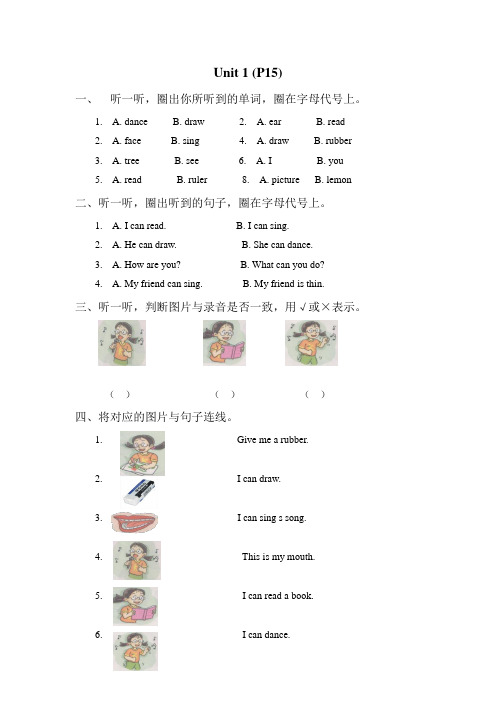
一、听一听,圈出你所听到的单词,圈在字母代号上。
1. A. dance B. draw2. A. ear B. read2. A. face B. sing 4. A. draw B. rubber3. A. tree B. see 6. A. I B. you5. A. read B. ruler 8. A. picture B. lemon二、听一听,圈出听到的句子,圈在字母代号上。
1. A. I can read. B. I can sing.2. A. He can draw. B. She can dance.3. A. How are you? B. What can you do?4. A. My friend can sing. B. My friend is thin.三、听一听,判断图片与录音是否一致,用√或×表示。
()()()四、将对应的图片与句子连线。
1. Give me a rubber.2. I can draw.3. I can sing s song.4. This is my mouth.5. I can read a book.6. I can dance.一、听一听,圈出你所听到的句子,圈在字母代号上。
1. A. I can read. B. I can draw.2. A. I can dance. B. I can sing.3. A. I can sing a song. B. I can read a book.4. A. I can draw a rubber. B. I can draw a ruler.5. A. What can you do? B. What can I do?6. A. I can read a picture book. B. You can read a picture book.7. A. Hello! I’m Ben. B. Hi! I’m Alice.8. A. Give me a pencil, please. B. Touch your pencil, please.二、在字母盒中圈出正确的单词。
4AM1U2知识点Abilities能力

4AM1U2知识点Abilities能力4AM1U2 知识点Abilities能力★背诵词汇:paint用颜料画画(还可作名词:paints颜料),draw绘画,read 阅读,write写,swim游泳,jump跳,fast, picture, very, well, high, climb, crawl★背诵词组:paint well画得好,draw a picture画画,read a book读书,write well写得好,swim fast游得快,jump high跳得高,climb a tree爬树,count to three数到三★背诵句型:1. Can you paint a picture? Yes, I can。
你会画画吗?是的,我会。
2.Can you skip, Danny? No, I can’t. 你会跳绳吗?不,我不会。
3.Can Alice run and swim? Yes, she can. She can run fast and swim well.爱丽丝会跑步和游泳吗?是的,她能跑得快。
她能游得好。
4. Danny can skate on the ice, but he can’t ride a bicycle or stand on his head. 丹尼会滑冰,但是不会骑自行车和倒立。
5.What can you do, Jill? I can skip a rope. 你会做什么?我会跳绳。
6. What can he do? He can draw. 他会做什么?他会绘画。
7. What do you like doing? 你喜欢做什么?I like swimming very much.我非常喜欢游泳。
8. This is our guest, Supergirl. 这是我们的客人,超级女生。
9. You’re both super! 你们两个都很棒!★掌握语法:1. 反义词:this---that; these---those;little(小的,年幼的)---big/old; good---bad2. 单复数:ability(能力)---abilities; pony(矮马)---ponies3. well(副词:好地)----good(形容词:好的)4. 现在进行时:be动词+doing,表示“正在做….”,常与now, look, listen等词连用:如:Super girl is coming. 超级女生来了。
